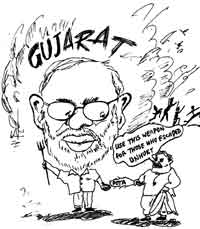>>>>>>>>>
Save Gujarat, Save India
 AS
SOON as the news of VHP-RSS violence against minorities was flashed by the TV
channels on 1 March, the day of All-India Bandh called by VHP, the CPI(ML) activists
took to the streets in Delhi to stage a protest demonstration the very same
day. Since then the Party and mass organisations have staged numerous demonstrations
all over the country. The Party General Secretary Dipankar Bhattacharya and
CPI(ML) MP Comrade Jayant Rongpi rushed to Gujarat on March 4 for a two-day
visit even as the state was reeling under violence and Ahemadabad was still
under curfew. This team, the frst by a political party, was followed by several
other, from the Party and mass organisations, which visited Ahemadabad and other
parts of Gujarat to get a firsthand account of the happenings, to express solidarity
with the victims and to offer relief and rehabilitation.
AS
SOON as the news of VHP-RSS violence against minorities was flashed by the TV
channels on 1 March, the day of All-India Bandh called by VHP, the CPI(ML) activists
took to the streets in Delhi to stage a protest demonstration the very same
day. Since then the Party and mass organisations have staged numerous demonstrations
all over the country. The Party General Secretary Dipankar Bhattacharya and
CPI(ML) MP Comrade Jayant Rongpi rushed to Gujarat on March 4 for a two-day
visit even as the state was reeling under violence and Ahemadabad was still
under curfew. This team, the frst by a political party, was followed by several
other, from the Party and mass organisations, which visited Ahemadabad and other
parts of Gujarat to get a firsthand account of the happenings, to express solidarity
with the victims and to offer relief and rehabilitation.
Addressing the press
in Delhi on 6 March, Comrade Dipankar called for the resignation of the Gujarat
Chief Minister Narendra Modi and Union Home Minister Advani. On March 9, CPI(ML)
had given a call for All-India protest day under the slogan “Save Gujarat, Save
India” which witnessed vigorous protests all over the country. Many other left
and democratic forces joined these protests. Narendra Modi Must Go! – this became
the main war cry in the protests. Meanwhile, Ayodhya was hotting up. There was
another round of natiowide protests on March 14 demanding a ban on VHP, arrest
of VHP leaders, and maintenance of status quo in Ayodhya. There was also a massive
rally of nearly a lakh people in Patna reiterating these demands.
The very next
day, Party activists were again on the streets in many states, launching street-corner
meetings and taking out marches protesting charade going on parallelly in Ayodhya.
Notable among them was the demonstration organised by AISA-RYA on March 15 itself
at Faizabad, a few kms away from Ayodhya, under very difficult circumstances.
CPI(ML) also joined hands with other left parties like CPI and CPI(M) in West
Bengal and Andhra Pradesh to launch united initiatives.
Meanwhile, there was
no sign of anti-minority violence abating in Gujarat. More than a month after
the carnage, Vajpayee made a belated visit to Gujarat, waxed eloquent there about
Rajdharma, but also revealed his true saffron colours by refusing to act against
Modi. On April 15, again the CPI(ML) observed protest day all over the country.
Next came the BJP’s National Executive meet at Goa which was brazen in its definace
of the pubic opinion in the country and defiance of an indefensible Modi. The
BJP made no secret of its intention to play hardball, disillusioning the liberal
camp that was hoping for some action against Modi by Vajpayee. The democratic
forces in the country can pick up the gauntlet and wage this war only by deepening
the movement against communal fascism among the broad masses.
The Party has also decided to organise a week-long campaign – Campaign against
Communal Fascism and for People’s Unity – from May 4-10, coinciding with the
day marking the beginning of the anti-British revolt of 1857. The highlight
of this campaign would be a Martyrs Mela in Faizabad on May 9-10 – a festival
dedicated to the memory of the martyrs of 1857, with cultural performances by
theatre groups and folk artistes, poster exhibitions, and anti-communal conventions
etc.
>>>>>>>>>
 AS
SOON as the news of VHP-RSS violence against minorities was flashed by the TV
channels on 1 March, the day of All-India Bandh called by VHP, the CPI(ML) activists
took to the streets in Delhi to stage a protest demonstration the very same
day. Since then the Party and mass organisations have staged numerous demonstrations
all over the country. The Party General Secretary Dipankar Bhattacharya and
CPI(ML) MP Comrade Jayant Rongpi rushed to Gujarat on March 4 for a two-day
visit even as the state was reeling under violence and Ahemadabad was still
under curfew. This team, the frst by a political party, was followed by several
other, from the Party and mass organisations, which visited Ahemadabad and other
parts of Gujarat to get a firsthand account of the happenings, to express solidarity
with the victims and to offer relief and rehabilitation.
AS
SOON as the news of VHP-RSS violence against minorities was flashed by the TV
channels on 1 March, the day of All-India Bandh called by VHP, the CPI(ML) activists
took to the streets in Delhi to stage a protest demonstration the very same
day. Since then the Party and mass organisations have staged numerous demonstrations
all over the country. The Party General Secretary Dipankar Bhattacharya and
CPI(ML) MP Comrade Jayant Rongpi rushed to Gujarat on March 4 for a two-day
visit even as the state was reeling under violence and Ahemadabad was still
under curfew. This team, the frst by a political party, was followed by several
other, from the Party and mass organisations, which visited Ahemadabad and other
parts of Gujarat to get a firsthand account of the happenings, to express solidarity
with the victims and to offer relief and rehabilitation.